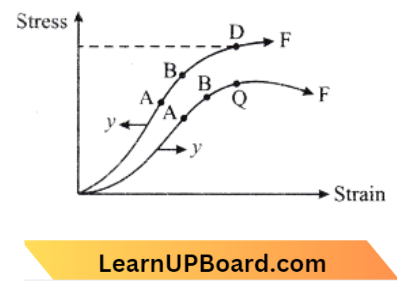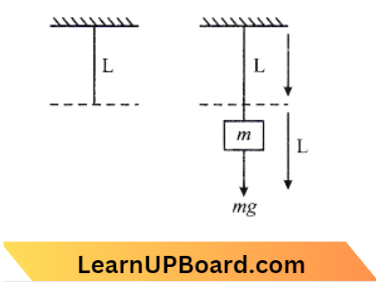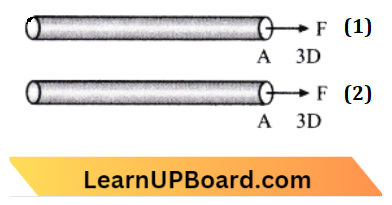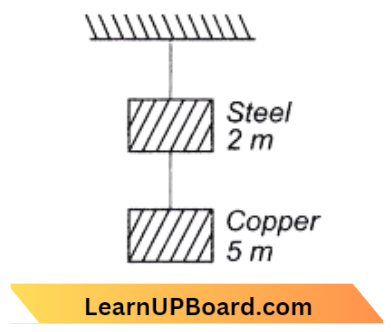Mechanical Properties Of Solids MCQs
NEET Physics For Mechanical Properties Of Solids Multiple Choice Questions
Question 1. The stress-strain curves are drawn for two different materials X and Y. It is observed that the ultimate strength point and the fracture point are close to each other for material X but are far apart for material Y. We can say that materials X and Y are likely to be (respectively):
- ductile and brittle
- brittle and ductile
- brittle and plastic
- plastic and ductile
Answer: 2. brittle and ductile
Given
The stress-strain curves are drawn for two different materials X and Y. It is observed that the ultimate strength point and the fracture point are close to each other for material X but are far apart for material Y.
As the given factors point and ultimate strength point are close for material X1 X is brittle and both points are apart for material ϒ Hence Cl is ductile X is brittle and Y is ductile.

Question 2. Given below are two statements: One is labeled as
Assertion and the other is labeled as Reason (R).
Assertion (A): The stretching of a spring is determined by the shear modulus of the material of the spring.
Reason (R): A coil spring of copper has more tensile strength than a steel spring of the same dimensions.
In the light of the above statements, choose the most appropriate answer from the options given below:
- Both (A) and (R) are true and (R) is not the correct explanation of (A).
- (A) is true but (R) is false
- (A) is false but (R) is true
- Both (A) and (R) are true and (R) is the correct explanation of (A).
Answer: 2. (A) is true but (R) is false
From the concept of Hook’s law, we have,
Normal Stress, (CT) = Ee
where E = Young’s Modulus of Elasticity and e is a strain which gives linear deformation of the object.
Also, Shear Stress, (x) = Gy
where G = Shear Modulus of Elasticity of the material and y is a shear strain which gives angular deformation of the object.
When we stretch a spring, the length of the wire does not change but experiences an angular twist. Hence shear modulus is used to determine the stretching of a spring.
The Assertion is True. Also, we know that for a given dimension, Young’s Modulus of Elasticity of steel is more than the Copper hence from equation (1). We can say that the tensile strength of Steel is more than that of Cu.
∴ The Reason is False.
Read and Learn More NEET Physics MCQs
Question 3. A wire of length L, area of cross-section A is hanging from a field support. The length of the wire changes to L1 when mass M is suspended from its free end. The expression for Young’s modulus is :
- \(\frac{\mathrm{Mg}\left(\mathrm{L}_1-\mathrm{L}\right)}{A L}\)
- \(\frac{\mathrm{Mg} \mathrm{L}}{A L_1}\)
- \(\frac{\mathrm{MgL}}{A\left(L_1-L\right)}\)
- \(\frac{\mathrm{Mg} \mathrm{L}}{A L}\)
Answer: 1. \(\frac{\mathrm{Mg}\left(\mathrm{L}_1-\mathrm{L}\right)}{A L}\)
Given
A wire of length L, area of cross-section A is hanging from a field support. The length of the wire changes to L1 when mass M is suspended from its free end.
Change in length, \(\Delta L=L_1-L\), Area, =A, force,
F = mg
Younger modules,\(\gamma =\frac{\text { Normal Stress }}{\text { Longitudinal Strain }}\)
⇒ \(\gamma =\frac{\frac{\mathrm{F}}{\mathrm{A}}}{\frac{\Delta \mathrm{L}}{\mathrm{L}}}\)
∴ \(\gamma=\frac{\left(\frac{\mathrm{Mg}}{A}\right)}{\left(\frac{\mathrm{L}_1-\mathrm{L}}{L}\right)}=\frac{\mathrm{Mg}\left(\mathrm{L}_1-\mathrm{L}\right)}{A \mathrm{~L}}\)
Question 4. When a block of mass M is suspended by a long wire of length L, the length of the wire becomes (L + l). The elastic potential energy stored in the extended wire is :
- MgL
- \(\frac{1}{2} M g l\)
- \(\frac{1}{2} M g L\)
- Mgl
Answer: 2. \(\frac{1}{2} M g l\)

Cross-Sectional Area = A
Original length = L
Elongation = l
⇒ \(\frac{\text { Energy stored }}{\text { Volume }} =\frac{1}{2} \text { stress } \times \text { strain }\)
⇒ \(\frac{E}{V} =\frac{1}{2} \times \frac{F}{A} \times \frac{\text { elongation }}{\text { length }}\)
⇒ \(\frac{E}{A L} =\frac{1}{2} \times \frac{m g}{A^{\prime}} \times \frac{l}{L}\)
∴ \(\mathrm{E} =\frac{1}{2} m g l\)
Mechanical Properties of Solids MCQs
Question 5. Two wires are made of the same material and have the same volume. The first wire has cross-sectional area A and the second wire has cross-sectional area 3A. If the length of the first wire is increased by At on applying a force F, how much force is needed to stretch the second wire by the same amount?
- 4F
- 6F
- 9F
- F
Answer: 3. 9F

Given
Two wires are made of the same material and have the same volume. The first wire has cross-sectional area A and the second wire has cross-sectional area 3A. If the length of the first wire is increased by At on applying a force F
For wire (1), \(\Delta l=\left(\frac{F}{A \gamma}\right) 3 l\) → Equation 1
For wire (2), \(\frac{F^{\prime}}{3 A}=\gamma \frac{\Delta l}{l}\)
⇒ \(\Delta l=\left(\frac{F^{\prime}}{3 A Y}\right) l\) → Equation 2
From eq. (1) and eq. (2),
we get, \(\Delta l =\frac{F}{A \gamma} 3 l-\left(\frac{F^{\prime}}{3 A Y}\right) l\)
∴ \(F^{\prime}\) =9 F
Question 6. The bulk modulus of a spherical object is B. If it is subjected to uniform pressure P, the fractional decrease in radius is:
- \(\frac{P}{B}\)
- \(\frac{B}{3 P}\)
- \(\frac{3 P}{B}\)
- \(\frac{P}{3 B}\)
Answer: 4. \(\frac{P}{3 B}\)
Bulk modulus (B) is the ratio of normal stress to volumetric strain,
B=\(\frac{\text { Normal stress }}{\text { Volumetric strain }}\)
=\(\frac{F / A}{\Delta V / V}=\frac{P}{\Delta V / V} \)
⇒ \(\frac{\Delta V}{V}=\frac{P}{B}\) [ P – pressure on the object] → Equation 1
Now from the question of fractional decrease in volumes
⇒ \(\frac{\Delta V}{V}=3 \frac{\Delta R}{R}\) → Equation 2
⇒ \({\left[V=\frac{4}{3} \pi R^3\right]}\)
From eq. (1) and (2), we get
∴ \(\frac{\Delta V}{V}=\frac{3 \Delta R}{R} = \frac{P}{B}\)
MCQs on Mechanical Properties of Solids for NEET
Question 7. The Young’s modulus of steel is twice that of brass. Two wires of the same length and the same area of cross-section, one of steel and another of brass are suspended from the same roof. If we want the lower ends of the wires to be at the same level, then the weight added to the steel and brass wires must be in the ratio of:
- 1: 2
- 2: 1
- 4: 1
- 1: 1
Answer: 2. 2: 1
Given
The Young’s modulus of steel is twice that of brass. Two wires of the same length and the same area of cross-section, one of steel and another of brass are suspended from the same roof. If we want the lower ends of the wires to be at the same level,
Young’s modulus, \(\gamma=\frac{W. I}{A \Delta l}\)
I, A and \(\Delta l\) are same for both the wires
⇒ \(\gamma \propto W\)
⇒ \(\frac{\gamma_s}{\gamma_b}=\frac{W_s}{W_b}=\frac{2}{1}\)
∴ \(\mathrm{W}_s: \mathrm{W}_b=\) 2: 1
NEET Physics MCQs
Question 8. The approximate depth of an ocean is 2700 m. The compressibility of water is 45.4 x 10-11 Pa-1 and the density of water is 103 kg/m3. What fractional compression of water will be obtained at the bottom of the ocean?
- 1.2 x 10-2
- 1.4×10-2
- 0.8×10-2
- 1.0×10-2
Answer: 1. 1.2 x 10-2
Depth of ocean, d=2700 m
Density of water, \(\rho=10^3 \mathrm{~kg} \mathrm{~m}^{-3}\)
Compressibility of water, \(\mathrm{K}=45.4 \times 10^{-11} \mathrm{~Pa}^{-1}\)
⇒ \(\frac{\Delta V}{V}\)=?
Excess pressure at the bottom, \(\Delta \mathrm{P}=\rho g d\)
=\(10^3 \times 10 \times 2700=27 \times 10^6 \mathrm{~Pa}\)
We know, \(\mathrm{B} =\frac{\Delta P}{(\Delta V / V)} \)
⇒ \(\frac{\Delta V}{(V)} =\frac{\Delta P}{B}=\mathrm{K} . \Delta \mathrm{P}\)
⇒ \((K \left.=\frac{1}{B}\right)\)
=\(45.4 \times 10^{-11} \times 27 \times 10^6\)
=\(1.2 \times 10^{-2}\)
MCQs on Mechanical Properties of Solids for NEET
Question 9. The copper of fixed volume V is drawn into a wire of length l. When the wire is subjected to a constant force F, the extension produced in the wire is Δl. Which of the following graphs is a straight line?
- \( \Delta l versus \frac{1}{l} \)
- \( \Delta l versus l^2 \)
- \( \Delta l versus \frac{1}{l^2} \)
- \( \Delta l versus l \)
Answer: 2. \(\Delta l versus l^2\)
⇒ \({ Young’s modulus }=\frac{\text { Longitudinal Stress }}{\text { Longitudinal Strain }}\)
Where, F= force applied
A = Area of cross-section
⇒ \(\gamma=\frac{\frac{F}{A}}{\frac{\Delta l}{l}}\) → Equation 1
⇒ \(\Delta l=\text { Change in length }\)
l= Original length And
V=A \(\times l=\text { Constant }\)
A = \(\frac{V}{l}\) → Equation 2
From (1) and (2),
we get, \(\gamma =\frac{F \times l \times l}{\Delta l \times V}\)
⇒ \(\Delta l =\frac{F}{V \times Y} \times l^2\)
⇒ \(\Delta l \propto l^2\)
∴ Where \(\mathrm{F}, \mathrm{V}, \gamma\) are constant
Question 10. The following four wires are made of the same material. Which of these will have the largest extension when the same tension is applied?
- Length = 50 cm, diameter = 0.5 mm
- Length =100 cm, diameter = 1 mm
- Length = 200 cm, diameter = 2 mm
- Length = 300 cm, diameter = 3 mm
Answer: 1. Length = 50 cm, diameter = 0.5 mm
We know that, \(\Delta L=\frac{F L}{A Y}\)
⇒ \(\Delta L \propto \frac{L}{d^2}\) { Since A=\(\frac{\pi d^2}{4}\}\)
This confirms that \(\Delta\) L will be the maximum for the wire when tension \(\frac{L}{A}\) maximum.
Mechanical Properties of Solids Questions NEET
Question 11. In the ratio of diameters, lengths, and Young’s modulus, of steel and copper wires shown in the figure, are p, q, and s respectively, then the corresponding ratio of increase in their length would be:

- \(\frac{7 q}{\left(7 s p^2\right)}\)
- \(\frac{7 q}{\left(5 s p^2\right)}\)
- \(\frac{2 q}{(5 s p)}\)
- \(\frac{7 q}{(5 s p)}\)
Answer: 2. \(\frac{7 q}{\left(5 s p^2\right)}\)
Given
In the ratio of diameters, lengths, and Young’s modulus, of steel and copper wires shown in the figure, are p, q, and s respectively,
We know that,
Young’s modulus,\(\gamma =\frac{\mathrm{FL}}{\mathrm{A} \Delta \mathrm{L}}\)
=\(\frac{\Delta \mathrm{FL}}{\pi \mathrm{D}^2 \Delta \mathrm{L}}\) → Equation 1
\(\Delta \mathrm{L} =\frac{\Delta \mathrm{FL}}{\pi \mathrm{D}^2 \mathrm{~L}}\)⇒ According to the questions,
⇒ \(\frac{\Delta \mathrm{L}_{\mathrm{S}}}{\Delta \mathrm{L}_{\mathrm{C}}}=\frac{\mathrm{F}_{\mathrm{S}}}{\mathrm{F}_{\mathrm{C}}} \cdot \frac{\mathrm{L}_{\mathrm{S}}}{\mathrm{L}_{\mathrm{C}}} \cdot \frac{\mathrm{D}_{\mathrm{C}}{ }^2 \mathrm{~L}_{\mathrm{S}}}{\mathrm{D}_{\mathrm{S}}{ }^2 \mathrm{~L}_{\mathrm{C}}}\) → Equation – 2
Here, \(F_S=(5 m+2 m)\) g=7 m g
⇒ \(\mathrm{F}_{\mathrm{C}}=5 \mathrm{mg},\)=?,
⇒ \(\frac{\mathrm{D}_{\mathrm{S}}}{\mathrm{D}_{\mathrm{C}}}\)=p,
⇒ \(\frac{\mathrm{L}_{\mathrm{S}}}{\mathrm{L}_{\mathrm{C}}}=\mathrm{s}\)
Putting in eq. (2), we get,
⇒ \(\frac{\Delta \mathrm{L}_{\mathrm{S}}}{\Delta \mathrm{L}_{\mathrm{C}}} =\frac{7 \mathrm{mg}}{5 \mathrm{mg}} \times q+\left(\frac{1}{\mathrm{P}}\right)^2\left(\frac{1}{\mathrm{~S}}\right)\)
=\(\frac{7 q}{5 p^2 \mathrm{~S}}\)
